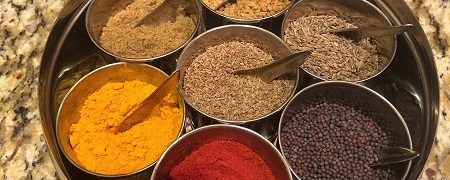Print Everyday Cabbage (shaak) Prep time: 10 mins Cook time: 15 mins Total time: 25 mins Serves: 6 This is a basic recipe to cook any vegetable in Gujarati style and it is referred as shaak. Usually there is some kind of a shaak with a meal (Gujarati thali). In vegetables like cauliflower, cabbage, green beans, […]
Vegetables and Chickpeas Tagine
Print Vegetables and Chickpeas Tagine Prep time: 30 mins Cook time: 30 mins Total time: 1 hour Serves: 6 The spices used in Moroccan Tagine recipes are very similar to spices used in Indian curries. I like to cook curries/stews with warm spices during winter months. It is very satisfying and comforting during cold season. I […]
Pav Bhaji
Print Pav Bhaji Prep time: 15 mins Cook time: 40 mins Total time: 55 mins Serves: 6 Pav (bread) Bhaji (mixed vegetables) is a street food available all over India. The bhaji should be soft and mashed which you can scoop up with a pav. This recipe uses small quantity of variety of vegetables which is […]
Turiya Patra nu Shaak
Print Turiya Patra nu Shaak Prep time: 15 mins Cook time: 20 mins Total time: 35 mins Serves: 4 Ingredients 2 medium or 1 large turiya (snake gourd, known as Chinese okra) 4 rolls of Patra, cooked or uncooked 3 tablespoons olive oil 1 teaspoon cumin seeds 1 teaspoon ground turmeric ¼ teaspoon chili powder 1 […]
Cachumber
Raw vegetables eaten with meal as a side dish is known as cachumber (salad). It varies depending on season and availability of vegetables. Print Everyday Cachumber Prep time: 15 mins Total time: 15 mins Serves: 4 Ingredients 2 Roma or plum tomatoes, thinly sliced 1 red onion, thinly sliced 2 serrano or jalapeno chilies, cut lengthwise […]
Undhiyu
Print Undhiyu Prep time: 20 mins Cook time: 40 mins Total time: 1 hour Serves: 4 This mixed vegetables recipe is quintessential Gujarati dish. It is a very famous dish from city of Surat in Gujarat. The variety of green beans called papadi used in this recipe are named after the city. The fresh papadi is […]
Dal Dhokli
Print Dal Dhokli Prep time: 2 hours Cook time: 1 hour 25 mins Total time: 3 hours 25 mins Serves: 4 Ingredients For Dal: ¾ cup oily or dry toover dal (split pigeon peas), uncooked 2 cups water 1 teaspoon salt or to taste Small (golf ball size) piece of jaggary or 3 teaspoons sugar ½ […]
Chickpea Flour Rolls and Fries
Print Khandavi Prep time: 20 mins Cook time: 10 mins Total time: 30 mins Serves: 6 The chickpea flour is known as besan and the rolls are known as Khandavi. This dish was my mother’s specialty. My mother used to make it on special occasions and whenever guests were coming over. She is not able to […]
Baigan Bharta
Print Baigan Bharta Prep time: 10 mins Cook time: 50 mins Total time: 1 hour Serves: 4 Ingredients 2 large eggplants (baigan) 1 bunch scallions, thinly sliced 2 medium Roma or plum tomatoes, ½ inch diced 3 garlic cloves, finely chopped 1 jalapeno or serrano chili, finely chopped 3 tablespoons canola oil 1 teaspoon cumin seeds […]
Bhindi Masala
Print Bhindi Masala Prep time: 15 mins Cook time: 25 mins Total time: 40 mins Serves: 4 Ingredients 1 lb. okras (bhindi) 1 medium yellow or red onion, ½ inch diced 1 medium plum or Roma tomato, ½ inch diced 2 garlic cloves, finely minced 1 jalapeno or serrano chili, finely chopped 1 inch piece of […]
Baghara Baigan
Print Baghara Baigan Prep time: 15 mins Cook time: 25 mins Total time: 40 mins Serves: 4 This eggplant curry is from city of Hyderabad, Southern part of India (in a state of Telangana), and it is usually served with Biryani. It is made with small purple egg sized eggplants (known as Indian eggplants). Ingredients 1 […]
Vegetable Biryani
Print Vegetable Biryani Prep time: 30 mins Cook time: 1 hour 30 mins Total time: 2 hours Serves: 4 This dish comes from city of Hyderabad (in State of Telangana), Southern part of India.. Ingredients For fried shallots and marinade: 1 lb. shallots, thinly sliced 3 tablespoons ghee or melted butter or canola oil ¼ cup […]
